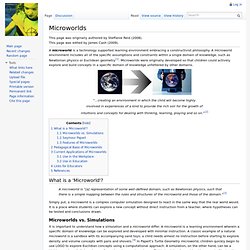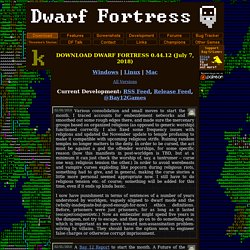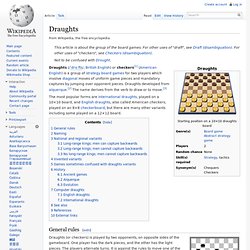

The Problem with Emergent Stories in Video Games. Some weeks ago, Dan Whitehead of Eurogamer wrote an article about how stories are best told in video games.

In short, he suggested that games excel when they let their systems tell their stories, and he criticized games that rely on cinematic tropes of storytelling and presentation: “[T]hat’s where gaming’s strength lies, not as storyteller but as story generator… Only when games accept that unique strength, take pride in it, and stop borrowing the clothes of others, will they truly achieve their potential as the only truly new creative medium of the last 100 years.” (‘Systems Vs. Stories’, Eurogamer, 22 June 2013) Narrative, Interactivity, Play, and Games. Narrative, Interactivity, Play, and Games: Four naughty concepts in need of discipline.

Roleplay for Workplace Training - Amersham, Buckinghamshire. Simulation. Wooden, mechanical, horse simulator during World War I. Simulation is used in many contexts, such as simulation of technology for performance optimization, safety engineering, testing, training, education, and video games. Often, computer experiments are used to study simulation models. Simulation is also used with scientific modelling of natural systems or human systems to gain insight into their functioning.[2] Simulation can be used to show the eventual real effects of alternative conditions and courses of action. Is chess a simulation of warfare? Military simulation. Military simulations, also known informally as war games, are simulations in which theories of warfare can be tested and refined without the need for actual hostilities.

Many professional analysts object to the term wargames as this is generally taken to be referring to the civilian hobby, thus the preference for the term simulation. Is draughts/checkers a simulation for something? Microworld. 1 Introduction Microworlds are a kind of educational technology used in constructionist instructional designs.

See also: Microworlds. This page was originally authored by Steffanie Reid (2008).

This page was edited by James Cash (2009). A microworld is a technology supported learning environment embracing a constructivist philosophy. A microworld environment includes all of the specific assumptions and constraints within a single domain of knowledge, such as Newtonian physics or Euclidean geometry[1]. Microworlds were originally developed so that children could actively explore and build concepts in a specific domain of knowledge unfettered by other domains. “...creating an environment in which the child will become highlyinvolved in experiences of a kind to provide the rich soil for the growth of intuitions and concepts for dealing with thinking, learning, playing and so on.”[2]
Chess as a microworld. Microworlds causes modes of thinking. Once Upon a Time (game) Once Upon a Time is a card game produced by Atlas Games, originally released in 1994 with a second edition published in 1995[2] and the current third edition in 2012.[3] One object of Once Upon a Time is to tell a fairy tale as a group.[1][2][4] While the story is developed by the whole group, the competitive aspect of the game is that each player has an individual goal of using all of the "Storytelling" cards he or she has in hand, and finishing the story with their own special "Happy Ever After" card.[4][5][6] Only one player at a time is the current storyteller, giving him or her a chance to play their Storytelling cards, while the other players have a chance to "interrupt" the story and become the storyteller if, for example, the storyteller mentions something on one of the interrupting player's cards.[1][5][6] One player at a time is the storyteller.

Expansions contain 55 additional cards. 2nd Edition expansions include:[8] 3rd Edition expansions include:[3] Other awards include: Once Upon a Time: Wil Wheaton, Amy Berg, Mike Phirman, and Chris "Doc" Wyatt on TableTop SE2E03. Bay 12 Games: Dwarf Fortress. 02/06/2019 Various consolidation and small moves to start the month.

I traced accounts for embezzlement networks and smoothed out some rough edges there, and made sure the mercenary groups based on organized religions (as opposed to generic worship) functioned correctly. I also fixed some frequency issues with religions and updated the November update to temple profaning to make it compatible with upcoming religious strife. Ruining random temples no longer matters to the deity. In order to be cursed, the act must be against a god the offender worships, for some specific reason (how this manifests in post-worldgen is TBD, but at a minimum it can just check the worship of, say, a tantrumer -- curse one way, religious tension the other.) Dwarf Fortress in 2013. This post has been highlighted as one of Gamasutra's best stories of 2013.

"What we've done is lay out a framework for version 1.0, and you just have a giant piece of paper with everything on it, and there's the stuff that's on the paper, and there's the stuff that's off the paper. " Tarn Adams and his brother Zach have been working on procedurally-generated fantasy game Dwarf Fortress for around 11 years now, although if you include the DragSlay and Slaves to Armok development work that preceded it -- and essentially molded the game's early beginnings -- it's more like 13 years. Although you can download and play the game for free right now, version 1.0 is still a long time coming. Minecraft. Chess. Chess is a two-player strategy board game played on a chessboard, a checkered gameboard with 64 squares arranged in an eight-by-eight grid.

It is one of the world's most popular games, played by millions of people worldwide in homes, parks, clubs, online, by correspondence, and in tournaments. Rules Initial position, first row: rook, knight, bishop, queen, king, bishop, knight, and rook; second row: pawns. The 'King's Game' Modern cultural place of chess. Draughts. Draughts (/ˈdrɑːfts/, British English) or checkers[1] (American English) is a group of strategy board games for two players which involve diagonal moves of uniform game pieces and mandatory captures by jumping over opponent pieces.

Draughts developed from alquerque.[2] The name derives from the verb to draw or to move.[3] Abstract strategy game. An abstract strategy game is a strategy game that minimizes luck and does not rely on a theme.[1][2] Almost all abstract strategy games will conform to the strictest definition of: a gameboard, card, or tile game in which there is no hidden information, no non-deterministic elements (such as shuffled cards or dice rolls), and (usually) two players or teams taking a finite number of alternating turns.[3][4] There is an intimate relationship between such games and puzzles: every board position presents the player with the puzzle, What is the best move?
All the King's Horses (story) "All the King's Horses" is a short story written in or before 1951 by Kurt Vonnegut.[1] It can be found in his collection of short stories Welcome to the Monkey House. It derives its title from a line in the Humpty Dumpty nursery rhyme. Pi Ying takes a sadistic pleasure in pointless exchanges of pieces meant to wear down Kelly, who begins to doubt himself over every move he makes.
Artificial life. Artificial life (often abbreviated ALife or A-Life[1]) is a field of study and an associated art form which examine systems related to life, its processes, and its evolution, through the use of simulations with computer models, robotics, and biochemistry.[2] The discipline was named by Christopher Langton, an American computer scientist, in 1986.[3] There are three main kinds of alife,[4] named for their approaches: soft,[5] from software; hard,[6] from hardware; and wet, from biochemistry. Artificial life imitates traditional biology by trying to recreate some aspects of biological phenomena.[7] The term "artificial intelligence" is often used to specifically refer to soft alife.[8] Overview[edit] Artificial life studies the logic of living systems in artificial environments in order to gain a deeper understanding of the complex information processing that defines such systems.
Philosophy[edit] Organizations[edit] Software-based - "soft"[edit] Techniques[edit] Notable simulators[edit] Game Of Life - John Conway. Uncanny valley. In an experiment involving the human lookalike robot Repliee Q2 (pictured above), the uncovered robotic structure underneath Repliee, and the actual human who was the model for Repliee, the human lookalike triggered the highest level of mirror neuron activity.[1] Etymology[edit] The concept was identified by the robotics professor Masahiro Mori as Bukimi no Tani Genshō (不気味の谷現象) in 1970.[5][6] The term "uncanny valley" first appeared in the 1978 book Robots: Fact, Fiction, and Prediction, written by Jasia Reichardt.[7] The hypothesis has been linked to Ernst Jentsch's concept of the "uncanny" identified in a 1906 essay "On the Psychology of the Uncanny".[8][9][10] Jentsch's conception was elaborated by Sigmund Freud in a 1919 essay entitled "The Uncanny" ("Das Unheimliche").[11] Hypothesis[edit] This area of repulsive response aroused by a robot with appearance and motion between a "barely human" and "fully human" entity is called the uncanny valley.
Theoretical basis[edit] Mate selection. Human Powered Computer Experiment / John Maeda. Blind Date – review. Blind Date. Would You Pay To Be Fake-Kidnapped? What It's Like to Be Kidnapped: Men's Lives. Ergodic literature. Ergodic literature is a term coined by Espen J. Aarseth in his book Cybertext—Perspectives on Ergodic Literature, and is derived from the Greek words ergon, meaning "work", and hodos, meaning "path". Authorial intent. Story within a story. Types of nested story[edit] Story within a story[edit] The inner stories are told either simply to entertain or more usually to act as an example to the other characters. 1st layer of Narrative: The player's. 2nd layer of narrative: the imbedded narrative. 3rd layer of narrative: the making of the player's narrative. Tetris. Tetris (Russian: Те́трис, pronounced [ˈtɛtrʲɪs]) is a tile-matching puzzle video game originally designed and programmed by Alexey Pajitnov in the Soviet Union.
It was released on June 6, 1984,[1] while he was working for the Dorodnicyn Computing Centre of the Academy of Science of the USSR in Moscow.[2] He derived its name from the Greek numerical prefix tetra- (all of the game's pieces contain four segments) and tennis, Pajitnov's favorite sport.[3][4] It is also the first entertainment software to be exported from the USSR to the US and published by Spectrum HoloByte for Commodore 64 and IBM PC. Thomas Was Alone. Spec Ops: The Line - Launch Trailer. Narrative. Narrators. Narrative Modes 01.